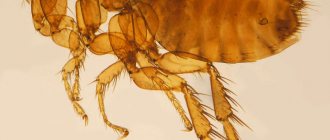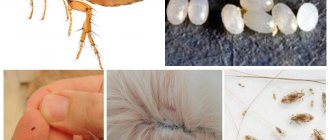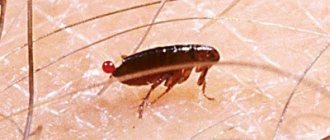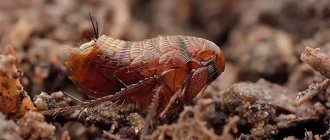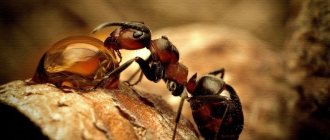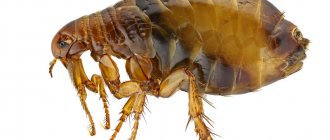Fleas are parasitic insects that have lived near humans for many thousands of years.
Most people are sure that fleas live exclusively on animals, but this opinion is wrong. Animals are used by parasites only as a source of food, but they can live in human housing, hiding in floor cracks, in upholstered furniture and even in children's toys.
- 2.1 Favorable microclimate for fleas
Life on media
Life cycle of a flea
If there is an owner, the insect's quality of life is noticeably higher, especially if the pet does not take care of itself. Experiments have shown that the survival rate of fleas in an apartment that parasitize cats is about 90% for males and 94% for females.
If you do not carry out preventive measures for your pet, the number of pests will gradually increase. Females lay eggs and the individuals cleaned by the animal are replaced by young animals. On average, fleas live in an apartment on cats and dogs for about 20-40 days.
Causes of death of fleas
Under natural conditions, a good half of the pests die as a result of the owner’s hygiene procedures. Unlike incoming parasites, such as mosquitoes, fleas do not leave after receiving the required dose of blood.
The hygienic instincts of animals acquired as a result of evolution are the main cause of death in fleas. At the same time, the thick fur of cats and dogs is a natural protection for the insect from external factors.
How many parasites do animals clean out?
In a week, a pet gets rid of approximately half of the pests living on it, which is about 5-10 fleas per day. In laboratory measurements, animals cleared about 40% of males and 20% of females.
In about three weeks, the cat gets rid of almost 90% of parasites. The remaining individuals who managed to escape the purge can be called long-livers. There have been recorded cases where parasites lasted on a pet for more than 60 days.
Read more ► Linen fleas, what do they look like, why are they dangerous and how to get rid of them?
Pest control
The lifespan of a flea, even under favorable conditions, is about 3 months - during this time it will have time to cause a lot of trouble. Therefore, you need to quickly purchase a special spray against blood-sucking pests. Standard packaging is designed to cover an area of about 10 square meters. You can carry out disinfestation yourself or with the help of a service that processes apartments.
- It is necessary to spray the product especially carefully in areas where fleas live. These are cracks in the floor, hard-to-reach places behind furniture, areas behind baseboards, etc. After treatment, leave the room for at least 2 hours.
- The floor should not be washed for at least 5 days. The flea nest, wherever it is, will suffer, but the eggs will be untouched. After a few days, larvae will emerge from them, which will die only after contact with the treated surface. If 3 weeks after disinsection the insects are still jumping, the procedure should be repeated.
Important!
When working with toxic substances, you must wear a respirator and gloves.
Flea Density
Sensitivity to parasites in animals varies and depends on the class and specific breed. Some pets carry out regular and sometimes even overly fanatical grooming, while others are calm about the life of fleas on their bodies.
This factor directly affects the density of pests. In animals that are more tolerant of parasites, this figure is noticeably higher. If a cat or dog is allergic to insects, then they can clean their fur 24 hours a day, even if the infestation is minimal or completely absent.
Scientists have conducted research on the hygiene habits of different felines. Extremely clean cats cleaned out about 20% of parasites each day, or about 70% per week. That is, the average lifespan of one individual was about 5 days .
A less active cat got rid of 4% of insects per day (about 20% per week). It turned out that the parasites barely survived until day 20. You also need to take into account the age of the pet. Young animals are more susceptible to infection than adult animals.
The fact is that young cats and dogs simply do not have experience in hygiene and have not yet learned how to comb themselves properly. Moreover, adult pets have stronger immunity, thicker skin and a different arrangement of capillaries.
Why are these bloodsuckers needed?
At the moment, there are many species of fleas (Pulex irritans, Ctenocephalides felis, Ctenocephalides canis, Xenopsylla cheopis, etc.). Without these small pests, many animals would simply die out.
After all, these bloodsuckers are part of the specific food chain of various animals. Also, these bloodsuckers transfer various diseases from one carrier to another.
Thus, blood-sucking insects (fleas) are useful not for people, but for certain viral microorganisms.
The role of such a bloodsucker in nature comes down to the fact that it is a parasite. Thus, this insect shortens the life of its “carrier” (cat, dog, etc.).
In general, fleas have a positive meaning in nature, but they are more likely an epidemic. Often these small pests are the causative agents and first carriers of various epidemiological infections.
According to numerous laboratory studies by biologists, this bloodsucker simultaneously carries 30 types of specific viruses and bacteria.
Fortunately, not all such insects have the same ability to transmit various pathogens (plague, typhoid, etc.). It all depends on the diet, type and physical condition of the bloodsucker.
Climatic conditions
All insects are afraid of low temperatures, including fleas. If the thermometer drops below 0⁰C, then the young animals will die in 3-5 days . The pest will survive up to +5⁰C for at most 10 days. The minimum temperature level when a flea can more or less exist is +10⁰C. The chance of survival in this case is 50/50.
Young animals are more vulnerable to low temperatures than adults. Larvae with laid eggs stop developing already at +13⁰С. At +10⁰С all offspring die.
Like other insects, a flea can hibernate, but provided that the temperature does not drop below +8⁰C. Heat also negatively affects the life of parasites. If the thermometer rises above +35 degrees, the pest will die in a matter of days. Dryness can also be considered a critical factor. Low air humidity has an extremely negative effect on both the offspring of the insect and the adults. The larvae begin to die inside the cocoons. In the summer months, when the heat stays at 30⁰C, the flea population decreases.
Read more ► Linen fleas, what do they look like, why are they dangerous and how to get rid of them?
Methods of destruction
Elimination of fleas begins with treating their habitats indoors. In carpets, animal bedding, upholstered furniture, cracks and baseboards you can see not only adults, but also larvae. If insecticides are used, insects die within 2 days
It is important to start extermination from the premises, and then process the hair of all pets
When carrying out procedures with carpets, you should know that chemicals do not penetrate into their depths. Meanwhile, it is there that several thousand pupae, larvae and eggs accumulate. Therefore, in such cases, a repeat procedure is required, performed after a certain period after the main disinsection.
The most effective ways to get rid of fleas from animals:
- Potent drops capable of eliminating a large number of individuals. The effect of the product can be observed very quickly, in addition, it retains its properties for 1-2 months. When treating a pet's fur, drops are applied to the animal's spine and withers.
- To remove fleas from young pets, a variety of shampoos are used. Due to their mild action, such products can be used quite often.
- An effective tool in the fight against bloodsuckers is special collars. They contain substances that have a detrimental effect on these insects. The collar should be used only after the animal has been bathed with appropriate shampoo or some other substance with similar properties.
- After using chemicals in the apartment, it is recommended to place fresh sprigs of lavender, wormwood, mint or chamomile in the suspected habitats of parasites and near the pet’s bedding. The pungent odor of these plants frightens fleas, but does not harm animals or people.
- Various aerosols and sprays with antiparasitic properties are considered effective. Treating an animal with such substances is only allowed using a special protective cone - so that the pet does not lick the insecticide from the fur and become poisoned.
To eliminate a flea colony, you need to properly treat your home and pets.
How long can an insect live without food?
Young animals that have just entered the adult stage must begin to feed within a week, otherwise they will simply die of starvation. In the most favorable climatic conditions, the individual survived for 2 weeks. It is also worth noting that insects at this stage are especially active in terms of feeding and cause much more discomfort to their host.
If the female has not previously fed on blood, then the life cycle of the newly emerged young increases noticeably - up to 30-40 days. In rooms with high humidity, this figure can approach 70 days. Similar conditions can be found in basements and attics of multi-story buildings. Whereas the parasite’s more familiar habitat – the fur of a pet and its bedding – is characterized by low humidity.
As soon as the flea finds a host, it begins to feed intensively. Literally within a day, the pest noticeably increases in size due to a good protein load. If the parasite is shed, then within 12-16 hours it loses its entire accumulated supply of proteins and decreases in size. After another 12 hours, due to lack of food, the insect may die.
If a flea has access to blood for about 2-3 hours a day, then this is considered malnutrition. For normal development, the insect needs periodic feeding. If a flea begins to feed from its owner, then after a while it develops a kind of drug addiction to the blood. A female fertilized on a carrier raises young animals that have already been planted on animal protein.
After 5 days of feeding on blood, shed fleas quickly die: females can last about 4 days, and males only 2 days . The survival rate of the parasite outside of a pet increases noticeably if it has fed on blood for no more than 12 hours, because the threshold for drug addiction has not yet been overcome.
Room treatment
Today, the choice of products in stores to combat parasites is very large - you can find drugs in the form of aerosols, concentrated solutions, various powders and pencils.
Concentrates have the greatest effect and are low cost. One bottle of this product is enough to treat the entire apartment. However, the drugs are very toxic and have an unpleasant odor; the procedure must be carried out with gloves and glasses, in the absence of children and animals.
The most famous con, “Taran”, “Dobrokhim”, etc.
Aerosols in cylinders can be used to treat office and residential premises. They are not affordable for everyone, but they are very convenient and easy to use, and sometimes have a pleasant aroma.
The treatment should be carried out with the windows and doors closed; it is possible to ventilate the room 2 hours after the procedure.
The following brands are popular: “Raptor”, “Dichlorvos”, “Reid”, etc.
Powders and pencils : mainly used to remove flea larvae in places where they are most concentrated (basements, attics, cellars). They are low cost and have a good effect in getting rid of parasites.
You can purchase the following names: “Phenaxin”, “Tornado”, “Baygon”, etc.
If you are unable to cope with harmful insects on your own, you can use the services of a special service that will professionally help solve the problem quickly and reliably.
The preparations used by the services are highly toxic, so it is better to leave home for 2-3 days during treatment, and upon return, thoroughly wash the floors and wipe all surfaces with special products.
Where do fleas live without a host?
For a full-fledged existence, an insect needs a host. If an adult somehow got into a living space where there are no cats, dogs or birds, then the flea can parasitize a person for some time. In the absence of at least some source of food, the pest lives behind the baseboard, window sill, under furniture, or climbs into the cracks between building panels: where there is high humidity.
Read more ► Linen fleas, what do they look like, why are they dangerous and how to get rid of them?
Man and fleas
Unlike head or pubic lice, fleas avoid human contact. The parasite can linger on clothing for a couple of days and periodically attack its owner, but the insect’s natural habitat is animals with widespread hair.
Under artificially created conditions, fleas have demonstrated the ability to live on human blood. But in the natural habitat this is rare. The parasite is too large to reproduce safely on human skin. And it is much more convenient for him to move on fur than on a bare or bristly surface.
It is extremely unlikely that fleas will reach a person's head. The most they can do is jump to ankle level. And as soon as the pest begins to move higher, the person will immediately feel it. Once on the skin, a flea simply bites, drinks blood and tries to leave the uncomfortable place as quickly as possible. The bite can be compared to a mosquito.
Lifespan
As already mentioned, temperature changes play a big role. In addition to it, the life expectancy of fleas is affected by:
- Humidity – low (but not too much) humidity is considered favorable for fleas;
- food source - parasites that do not receive fresh blood for a long time live longer;
- invariability of an environmental parameter - insects living in places with constant fluctuations in humidity and temperature develop the ability to fall into torpor, as a result of which life expectancy becomes longer.
When fleas reproduce, what is important is the number of descendants from a single flea, and not the speed of development of the larvae. As a rule, the process of reproduction of their own kind is continuous, therefore, when fighting blood-sucking animals, a person must destroy not only the parasites visible on the animal’s fur, but also the larvae hiding in secluded places
Ideal living conditions for parasites depend on air humidity and temperature. The lifespan of rat fleas is two months at a temperature of 14 degrees and a humidity of 60%. Parasites living in an apartment can live at the same temperature and air levels as rat fleas, unless, of course, they try to destroy them using special means
It is also important that the parasites are not left without food. At high air temperatures, insects do not live long, about 4 weeks and grow very large, but the development of eggs and larvae, under such conditions, proceeds faster, hence the reproduction stage is reduced
At high air temperatures, insects do not live long, about 4 weeks, and grow very large, but the development of eggs and larvae, under such conditions, proceeds faster, hence the reproduction stage is reduced.
At normal temperatures, larvae form in about a month, at high temperatures about 7 days. The eggs take fourteen days to develop, and the insect spends the same amount of time at the pupal stage.
Parasites do not live long, even under favorable conditions, since they are killed by the hosts themselves. Animals bite parasites out of their fur. Bloodsuckers also die from their own infections. But individual individuals can survive their owners, because after the death of the food source, the insects instantly leave the animal’s corpse and go in search of a new victim.
Interesting! During the process of evolution, many animals have changed in appearance. Scientists have found that the modern flea looks almost the same as its ancestors.
Fleas do not have wings, and they move by jumping with the help of three pairs of long and strong limbs. Some species have shorter paws, so they are constantly on the host's body. The paw consists of five segments and ends with sharp bristles-claws, forked at the end.
At the back of the abdomen is the pygidium, a sensory organ covered with tactile hairs. They react to small changes in air and warn of danger.
The reproductive system of the female consists of the oviduct, ovaries and spermatic receptacle (in the shape of a curved flask), and of the males - the genital claw (copulatory organ).
There are antennas behind the eyes. With them, males hold onto females during mating. The rest of the time they are in the antennal fossae.
The type of oral cavity is piercing-sucking. After biting the skin, the flea enlarges the wound, secretes saliva, which prevents blood clotting, then penetrates deeper and moves to the blood vessel, where it sucks blood. A flea cannot crawl completely under the skin.
How long fleas live will greatly depend on the conditions under which they live. Insects are very unpretentious, but in unfavorable conditions their life cycle is shortened and disrupted. In order for the parasite to live an average life (60-90 days), lay up to 500 eggs and eat at least 60-100 times, it needs the following habitat parameters:
- For rat fleas – humidity 60%, temperature 14-15 degrees
- For chicken fleas – humidity 80%, temperature – 20-25 degrees
- For fleas of dogs and cats – humidity 60%, temperature – up to 25 degrees
